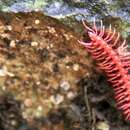Brief Summary
provided by EOL authors
This new millipede is known as "a shocking pink dragon millipede". Its name came from its vivid pink color and a spiny toxic structure. The taxon paper about this species was officially published in 2007. The specimen was collected and believed to be found only in the Hup Pa Tard limestone cavern within the Greater Mekong in Thailand.The shocking pink dragon millipede is identified to be the largest species of its genus. (1)
- license
- cc-by-3.0
- copyright
- Enghoff, Henrik; Sutcharit, Chirasak; Panha, Somsak
- bibliographic citation
- Enghoff, Henrik; Sutcharit, Chirasak; Panha, Somsak (2007). "The shocking pink dragon millipede, Desmoxytes purpurosea, a colourful new species from Thailand". Zootaxa 1563: 31–36. ISSN 1175-5326
- author
- Chulabush Khatancharoen
Morphology
provided by EOL authors
Length ca. 3 cm (both sexes), width of midbody pro- and metazoa 1.8 and 3.2 mm (male) / 2.5-2.6 and 4.0 mm (female). Colour of living animals is purple to shocking pink, head brownish, antennae black; colour retained after 10 days in alcohol but faded to light brown after 10 months. Head quite densely setose except on almost naked vertex, narrower than collum. Epicranial suture distinct. Antennae very long, reaching back to body ring 8 (male) or 6 (female). Collum as broad as body ring 2, with 3 transverse rows of setae, 4+4 anterior, 1+1 intermediate, 2+2 posterior, lateral setae of posterior row displaced anteriad almost halfway to intermediate row. Body parallel-sided from ring 7 to 15, anteriorly and especially posteriorly gradually tapering. Metaterga with two transverse rows of setiferous spines; metaterga 2-8 with 2+2 anterior and 2+2 posterior spines, lateral spines of posterior rows much longer than the others; metagerga 9-17 with 2+2 small, rosethornlike anterior spines and 3+3 posterior spines, lateral ones very long, intermeditate ones shorter, mesal ones shortest. Metatergum 18 with 2+2 anterior and 3+3 (or 3+4) posterior spines, all posterior spines of equal length; metatergum 19 with 2+2 anterior and 2+2 (or 2+3) posterior setae which are not on spines or tubercles. Axial line not visible. Paraterga wing-shaped, tip bent posteriad. Paraterga on collum almost horizontal, with one setiferous notch on anterior edge. Paraterga of rings 2–19 longer, directed obliquely upwards at ca. 45° in anterior part of body, becoming gradually more horizontal towards the rear, on rings 17–19 directed straight posteriad, anterior edge of paraterga 2–18 with 2 small setiferous notches. Surface finely shagreened, slightly more coarsely so on metazona (but not on paraterga). Suture between pro- and metazona smooth. Ozopores visible from above, located in distalmost notch on anterior paratergal edge. Transverse sulcus evident on metaterga 5–18. Pleurosternal carinae poorly developed on body rings 2-3, absent from others. Preanal projection simple, conoid, with a pair of tiny setiferous lateral knobs near tip. Subanal scale trapezoid, posterior margin very slightly convex between pair of setae. Sterna quite densely setose. A simple transverse, trapezoid, sparsely setose lamina between male coxae 4. Distal margin of lamina sometimes slightly concave. A pair of round structure at base of posterior side of lamina. Legs very long and slender as seen from above, projecting laterad from body by maximum body width in females, and even more than maximum body width in males. Male femora 5 and 6 distinctly humped Gonopods. Shaft very slender, almost straight, postfemoral part strongly condensed.
- license
- cc-by-3.0
- copyright
- Enghoff, Henrik; Sutcharit, Chirasak; Panha, Somsak
- bibliographic citation
- Enghoff, Henrik; Sutcharit, Chirasak; Panha, Somsak (2007). "The shocking pink dragon millipede, Desmoxytes purpurosea, a colourful new species from Thailand". Zootaxa 1563: 31–36. ISSN 1175-5326
- author
- Chulabush Khatancharoen
Desmoxytes purpurosea: Brief Summary
provided by wikipedia EN
Desmoxytes purpurosea (shocking pink dragon millipede) also known as dragon millipede, is a spiny and toxic millipede named for its vivid pink color. It was formally described in 2007 from a specimen collected at the Hup Pa Tard limestone cavern in the Uthai Thani Province of Thailand. Among the largest species of its genus, the adult millipede is approximately 3 cm (1.2 in) long. It lives in the open on leaf litter. Large numbers of them occur after rain showers. The millipede has glands that produce hydrogen cyanide to protect it from predators, which causes it to smell like almonds. Its toxicity is advertised by its aposematic color.
The shocking pink dragon millipede was named third in the top ten new species list of 2008 by the International Institute for Species Exploration.
Other species of genus Desmoxytes can be brightly colored, sometimes in shades of red, as in Desmoxytes rubra.
- license
- cc-by-sa-3.0
- copyright
- Wikipedia authors and editors

